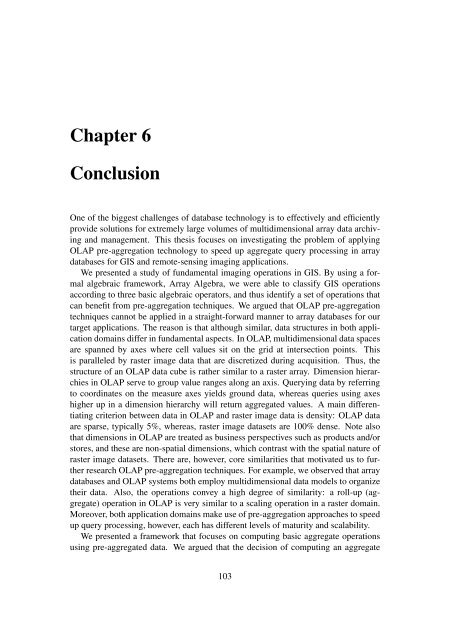Applying OLAP Pre-Aggregation Techniques to ... - Jacobs University
Applying OLAP Pre-Aggregation Techniques to ... - Jacobs University
Applying OLAP Pre-Aggregation Techniques to ... - Jacobs University
You also want an ePaper? Increase the reach of your titles
YUMPU automatically turns print PDFs into web optimized ePapers that Google loves.
Chapter 6<br />
Conclusion<br />
One of the biggest challenges of database technology is <strong>to</strong> effectively and efficiently<br />
provide solutions for extremely large volumes of multidimensional array data archiving<br />
and management. This thesis focuses on investigating the problem of applying<br />
<strong>OLAP</strong> pre-aggregation technology <strong>to</strong> speed up aggregate query processing in array<br />
databases for GIS and remote-sensing imaging applications.<br />
We presented a study of fundamental imaging operations in GIS. By using a formal<br />
algebraic framework, Array Algebra, we were able <strong>to</strong> classify GIS operations<br />
according <strong>to</strong> three basic algebraic opera<strong>to</strong>rs, and thus identify a set of operations that<br />
can benefit from pre-aggregation techniques. We argued that <strong>OLAP</strong> pre-aggregation<br />
techniques cannot be applied in a straight-forward manner <strong>to</strong> array databases for our<br />
target applications. The reason is that although similar, data structures in both application<br />
domains differ in fundamental aspects. In <strong>OLAP</strong>, multidimensional data spaces<br />
are spanned by axes where cell values sit on the grid at intersection points. This<br />
is paralleled by raster image data that are discretized during acquisition. Thus, the<br />
structure of an <strong>OLAP</strong> data cube is rather similar <strong>to</strong> a raster array. Dimension hierarchies<br />
in <strong>OLAP</strong> serve <strong>to</strong> group value ranges along an axis. Querying data by referring<br />
<strong>to</strong> coordinates on the measure axes yields ground data, whereas queries using axes<br />
higher up in a dimension hierarchy will return aggregated values. A main differentiating<br />
criterion between data in <strong>OLAP</strong> and raster image data is density: <strong>OLAP</strong> data<br />
are sparse, typically 5%, whereas, raster image datasets are 100% dense. Note also<br />
that dimensions in <strong>OLAP</strong> are treated as business perspectives such as products and/or<br />
s<strong>to</strong>res, and these are non-spatial dimensions, which contrast with the spatial nature of<br />
raster image datasets. There are, however, core similarities that motivated us <strong>to</strong> further<br />
research <strong>OLAP</strong> pre-aggregation techniques. For example, we observed that array<br />
databases and <strong>OLAP</strong> systems both employ multidimensional data models <strong>to</strong> organize<br />
their data. Also, the operations convey a high degree of similarity: a roll-up (aggregate)<br />
operation in <strong>OLAP</strong> is very similar <strong>to</strong> a scaling operation in a raster domain.<br />
Moreover, both application domains make use of pre-aggregation approaches <strong>to</strong> speed<br />
up query processing, however, each has different levels of maturity and scalability.<br />
We presented a framework that focuses on computing basic aggregate operations<br />
using pre-aggregated data. We argued that the decision of computing an aggregate<br />
103
















